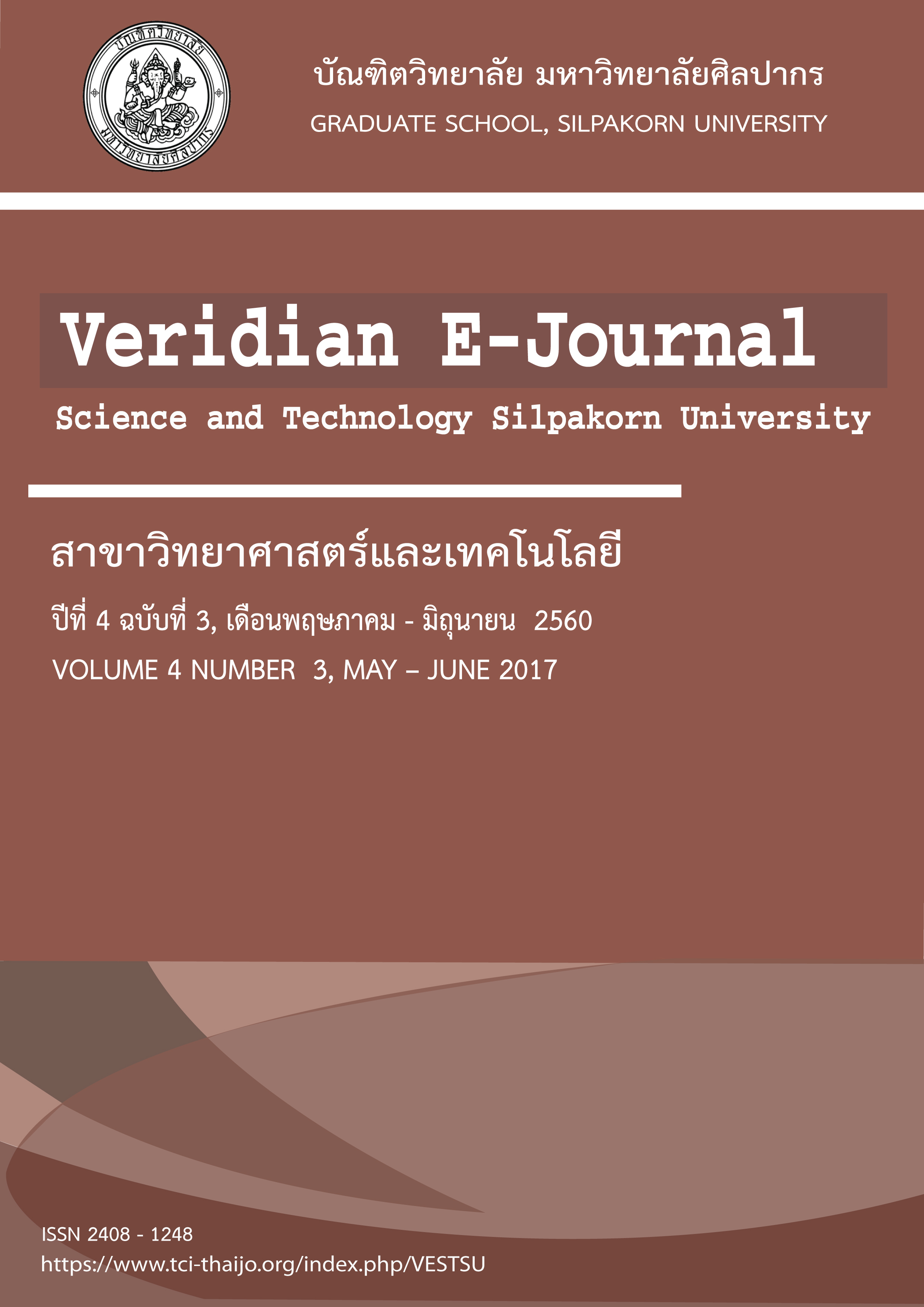การศึกษาสภาพการเกิดอุทกภัยในพื้นที่ลุ่มน้ำบางปะกง - ปราจีนบุรี
Main Article Content
Abstract
การศึกษาครั้งนี้มีวัตถุประสงค์เพื่อศึกษาสภาพการเกิดอุทกภัยในลุ่มน้ำบางปะกง – ปราจีนบุรี โดยการทบทวนข้อมูลต่างๆ ที่เกี่ยวข้อง เพื่อทำการวิเคราะห์ ปัจจัย ข้อมูลที่เป็นพื้นฐานการศึกษา สภาพน้ำท่วมที่เคยเกิดและการคาดการณ์ จากการทบทวนข้อมูลต่างๆ ที่เกี่ยวข้อง พบว่า ลักษณะภูมิประเทศของแม่น้ำปราจีนบุรีและแม่น้ำสาขาที่เกี่ยวข้องทางด้านต้นน้ำ ได้แก่ แควหนุมานและคลองพระปรงจะมีลักษณะเป็นที่สูงชันตอนบนของลุ่มน้ำ และมีจุดเปลี่ยนความชันมาเป็นที่ราบเริ่มตั้งแต่บริเวณด้านแม่น้ำปราจีนบุรีที่ อ.กบินทร์บุรี จังหวัดปราจีนบุรี ไปตามแม่น้ำปราจีนบุรี ผ่าน อ.ศรีมหาโพธิ อ.เมืองปราจีนบุรี และ อ.บ้านสร้าง จนบรรจบกับแม่นครนายกเป็นแม่น้ำบางปะกง ซึ่งที่ได้รับอิทธิพลการขึ้นลงจากน้ำทะเล ทำให้การระบายน้ำช้าลง จึงเกิดอุทกภัยในพื้นที่เป็นประจำในช่วงเดือนกันยายนถึงเดือนพฤศจิกายน โดยพื้นที่หลักที่เกิดปัญหาอุทกภัยเป็นประจำ ได้แก่ อ.กบินทร์บุรี อ.ศรีมหาโพธิ อ.เมืองปราจีนบุรี และ อ.บ้านสร้าง โดยมีพื้นที่โครงการชลประทานที่สำคัญในบริเวณดังกล่าว คือโครงการส่งน้ำและบำรุงรักษาบางพลวง และพื้นที่ชลประทานท่าแห ปีที่เกิดอุทกภัยใหญ่ในพื้นที่ได้แก่ ปี พ.ศ.2556 โดยค่าระดับน้ำหลากสูงสุดที่สถานี KGT.3 อ.กบินทร์บุรี จ.ปราจีนบุรี ซึ่งถือเป็นจุดต้นทางของการเกิดอุทกภัยในพื้นที่ วัดได้ที่ +11.99 ม.รทก. เป็นปริมาณน้ำ 729.75 ลบ.ม./วินาที ในขณะที่ระดับตลิ่งที่สถานี KGT.3 มีค่า +10.94 ม.รทก. มีความจุอยู่ที่ 578 ลบ.ม./วินาที
แม่น้ำปราจีนบุรี โดยทั่วไปมีความจุเฉลี่ยอยู่ที่ 444 ลบ.ม./วินาที ทำให้มีปริมาณน้ำท่วมบนพื้นดิน โดยสามารถสรุปสาเหตุของปัญหาอุทกภัยได้นอกเหนือจากปริมาณน้ำฝน และน้ำท่าเป็นสาเหตุจากธรรมชาติ ที่ไม่สามารถควบคุมได้ คือด้านกายภาพจากการบริหารจัดการและทางกายภาพ ประกอบด้วย ด้านกายภาพได้แก่ 1) โครงสร้างป้องกัน/บริหารจัดการที่มีอยู่ชำรุด 2) การขาดแคลนอ่างเก็บน้ำในการชะลอน้ำหลาก 3) ลำน้ำตื้นเขิน/มีการกีดขวางทางน้ำ และ 4) โครงสร้างในการบริหารจัดการ/ป้องกันน้ำท่วมยังไม่เพียงพอกับปริมาณน้ำหลาก ด้านการบริหารจัดการได้แก่ 1)การเฝ้าระวังสถานการณ์ คาดการณ์ยังไม่เหมาะสม/เพียงพอทำให้การบริหารจัดการองค์ประกอบต่างๆ เช่น เขื่อน ปตร. ฯลฯ ยังไม่เหมาะสมที่สุด และ 2) การใช้ที่ดินบางส่วนไม่สอดคล้องกับการระบายน้ำ/บริหารจัดการน้ำ เช่น มีการพัฒนาพื้นที่น้ำท่วมเป็นประจำ ฯลฯ
Bangpakong and Prachinburi Rivers are frequently faced by flood every year and the latest huge flood occurred in 2013. Therefore, the main objective of this study is to study the flood characteristics which is very crucial. The study is done by literature review with collecting water resources data including historical flood events to identify issues and problems in the Bangpakong-Prachinburi River Basin. The data shows that the upstream tributaries especially Hanuman River and Phraprong River have their topographic slope significantly change. The steep slope appears at the upstream and changes to mild slope through floodplain starting from Prachinburi River at Kabinburi District. Those rivers flow through Kabin Buri, Si Maha Phot, Mueang Prachinburi and Ban Sang District in Prachinburi Province. Then the rivers finally merges with Nakornnayok River in Nakornnayok Province to form Bangpakong River and converge out to the Gulf of Thailand. They are affected by tidal at the Gulf of Thailand those are impacted to high sea level during September to November, cause slow drainage. The major flooding areas are Kabin Buri, Si Maha Phot, Mueang Prachinburi, and Ban Sang Districts, where located in Bang Pluang Operation and Maintenance Project and Thahae Irrigation Area. In 2013, they were inundation in Kabin Buri district, Prachinburi Province (KGT.3 station). The highest water lever is +11.99 m.s.l, 729.75 m3/s , while the river bank level of KGT.3 is +10.94 m.s.l and capacity is 578 m3/s.
The capacity of Prachinburi River about 444 m3/s. It’s affected to overflow and flood. The summary of flooding ploblem are the inadequacy of flood protection projects and flood management specifically 1) Disrepair of flood control structures, 2) Insufficiency of flood control by reservoirs, 3) Carelessness of watercourse maintenance or dredging waterway 4) Insufficiency of flood projection management. Finally, another possible cause could be an ineffectiveness of water resources management such as 1) Flood warning system and flood forecasting system are inapplicable or are inadequate to manage flooding problem leading to difficulty in operating dam and floodgate 2) Lack or no enforcement of land use management to control urban development area depart from flood area.
